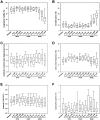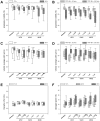Effects of cationic antimicrobial peptides on liquid-preserved boar spermatozoa
- PMID: 24940997
- PMCID: PMC4062521
- DOI: 10.1371/journal.pone.0100490
Effects of cationic antimicrobial peptides on liquid-preserved boar spermatozoa
Abstract
Antibiotics are mandatory additives in semen extenders to control bacterial contamination. The worldwide increase in resistance to conventional antibiotics requires the search for alternatives not only for animal artificial insemination industries, but also for veterinary and human medicine. Cationic antimicrobial peptides are of interest as a novel class of antimicrobial additives for boar semen preservation. The present study investigated effects of two synthetic cyclic hexapeptides (c-WFW, c-WWW) and a synthetic helical magainin II amide derivative (MK5E) on boar sperm during semen storage at 16 °C for 4 days. The standard extender, Beltsville Thawing Solution (BTS) containing 250 µg/mL gentamicin (standard), was compared to combinations of BTS with each of the peptides in a split-sample procedure. Examination revealed peptide- and concentration-dependent effects on sperm integrity and motility. Negative effects were more pronounced for MK5E than in hexapeptide-supplemented samples. The cyclic hexapeptides were partly able to stimulate a linear progressive sperm movement. When using low concentrations of cyclic hexapeptides (4 µM c-WFW, 2 µM c-WWW) sperm quality was comparable to the standard extender over the course of preservation. C-WFW-supplemented boar semen resulted in normal fertility rates after AI. In order to investigate the interaction of peptides with the membrane, electron spin resonance spectroscopic measurements were performed using spin-labeled lipids. C-WWW and c-WFW reversibly immobilized an analog of phosphatidylcholine (PC), whereas MK5E caused an irreversible increase of PC mobility. These results suggest testing the antimicrobial efficiency of non-toxic concentrations of selected cyclic hexapeptides as potential candidates to supplement/replace common antibiotics in semen preservation.
Conflict of interest statement
Figures


References
-
- Rossi LM, Rangasamy P, Zhang J, Qiu XQ, Wu GY (2008) Research advances in the development of peptide antibiotics. J Pharm Sci 97: 1060–1070. - PubMed
-
- Hancock RE, Patrzykat A (2002) Clinical development of cationic antimicrobial peptides: from natural to novel antibiotics. Curr Drug Targets Infect Disord 2: 79–83. - PubMed
-
- Epand RM, Vogel HJ (1999) Diversity of antimicrobial peptides and their mechanisms of action. Biochim Biophys Acta 1462: 11–28. - PubMed
-
- Lohner K, Blondelle SE (2005) Molecular mechanisms of membrane perturbation by antimicrobial peptides and the use of biophysical studies in the design of novel peptide antibiotics. Comb Chem High Throughput Screen 8: 241–256. - PubMed
Publication types
MeSH terms
Substances
LinkOut - more resources
Full Text Sources
Other Literature Sources
Medical

